Financial Decision Making and Ratio Analysis Report: Skanska Plc
VerifiedAdded on 2022/02/17
|15
|3696
|38
Report
AI Summary
This report evaluates financial decision-making processes, focusing on accounting, finance, and ratio analysis for Skanska Plc, a UK-based construction company. The report begins with definitions of accounting and finance, highlighting their importance and roles within the company. It explores financial statements, budget creation, and tax assessment. Task 2 delves into ratio analysis, calculating and analyzing key financial ratios such as return on capital employed, net profit margin, current ratio, average receivable days, and average payable days for 2018 and 2019. The analysis provides insights into Skanska Plc's financial performance and offers strategic recommendations based on the calculated ratios and overall financial health. The report emphasizes the interconnectedness of finance and accounting in achieving business objectives and expansion.

Financial Decision Making
1
1
Paraphrase This Document
Need a fresh take? Get an instant paraphrase of this document with our AI Paraphraser

Executive Summary
Financial decision making is the way of choosing a business-oriented supportive decision by
using a potential business strategy. Decision making is a practical task of a manager. An
organisation runs and operates with the help of a manager. Undertaking decision depends on
the accounting, finance, importance of accounting and finance, duties and roles of
accounting, ratio analysis and then choosing the best alternative from several is the way of
decision making. This report is going to evaluate those topics on behalf of Skanska Plc.
2
Financial decision making is the way of choosing a business-oriented supportive decision by
using a potential business strategy. Decision making is a practical task of a manager. An
organisation runs and operates with the help of a manager. Undertaking decision depends on
the accounting, finance, importance of accounting and finance, duties and roles of
accounting, ratio analysis and then choosing the best alternative from several is the way of
decision making. This report is going to evaluate those topics on behalf of Skanska Plc.
2
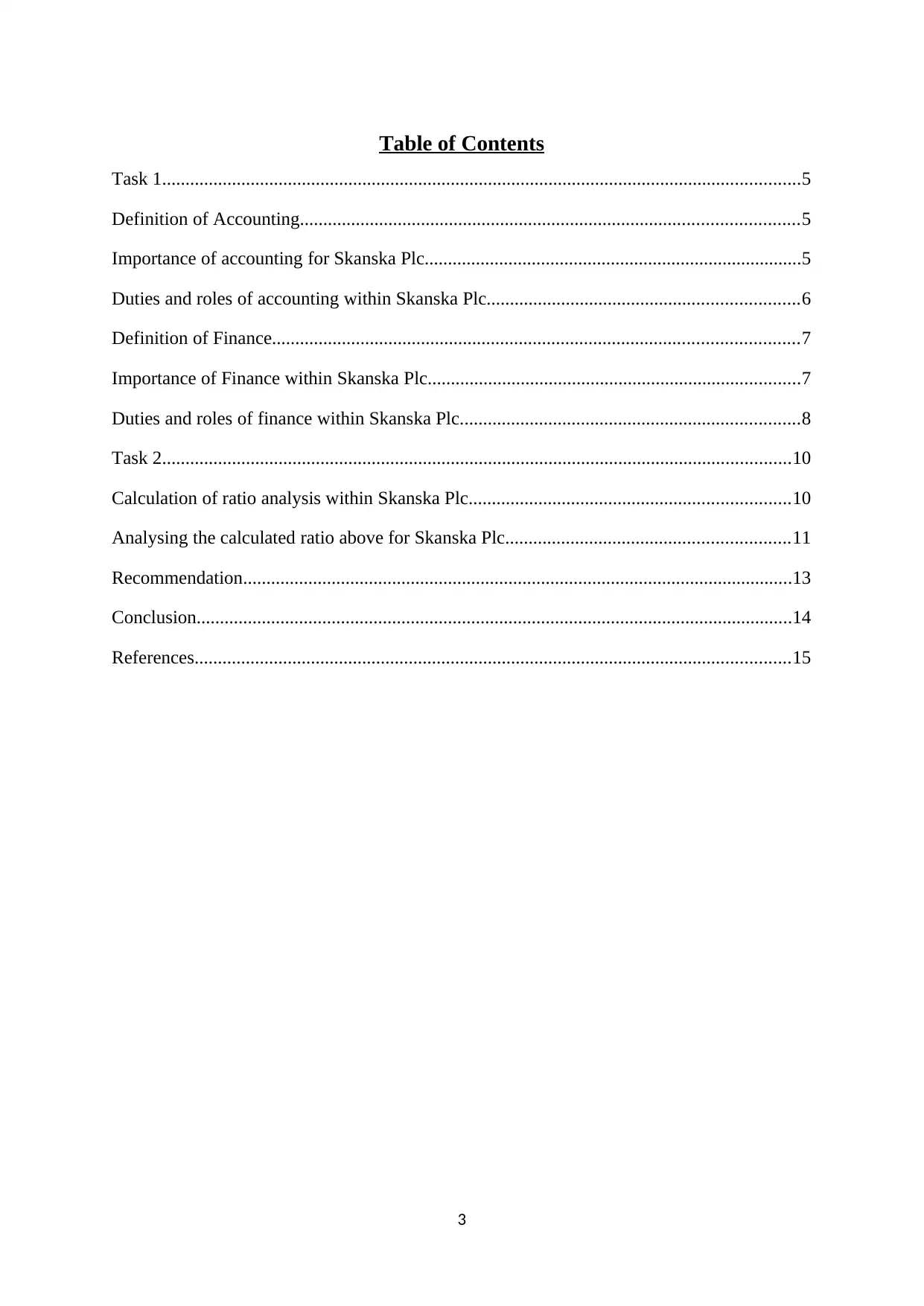
Table of Contents
Task 1.........................................................................................................................................5
Definition of Accounting...........................................................................................................5
Importance of accounting for Skanska Plc.................................................................................5
Duties and roles of accounting within Skanska Plc...................................................................6
Definition of Finance.................................................................................................................7
Importance of Finance within Skanska Plc................................................................................7
Duties and roles of finance within Skanska Plc.........................................................................8
Task 2.......................................................................................................................................10
Calculation of ratio analysis within Skanska Plc.....................................................................10
Analysing the calculated ratio above for Skanska Plc.............................................................11
Recommendation......................................................................................................................13
Conclusion................................................................................................................................14
References................................................................................................................................15
3
Task 1.........................................................................................................................................5
Definition of Accounting...........................................................................................................5
Importance of accounting for Skanska Plc.................................................................................5
Duties and roles of accounting within Skanska Plc...................................................................6
Definition of Finance.................................................................................................................7
Importance of Finance within Skanska Plc................................................................................7
Duties and roles of finance within Skanska Plc.........................................................................8
Task 2.......................................................................................................................................10
Calculation of ratio analysis within Skanska Plc.....................................................................10
Analysing the calculated ratio above for Skanska Plc.............................................................11
Recommendation......................................................................................................................13
Conclusion................................................................................................................................14
References................................................................................................................................15
3
⊘ This is a preview!⊘
Do you want full access?
Subscribe today to unlock all pages.

Trusted by 1+ million students worldwide
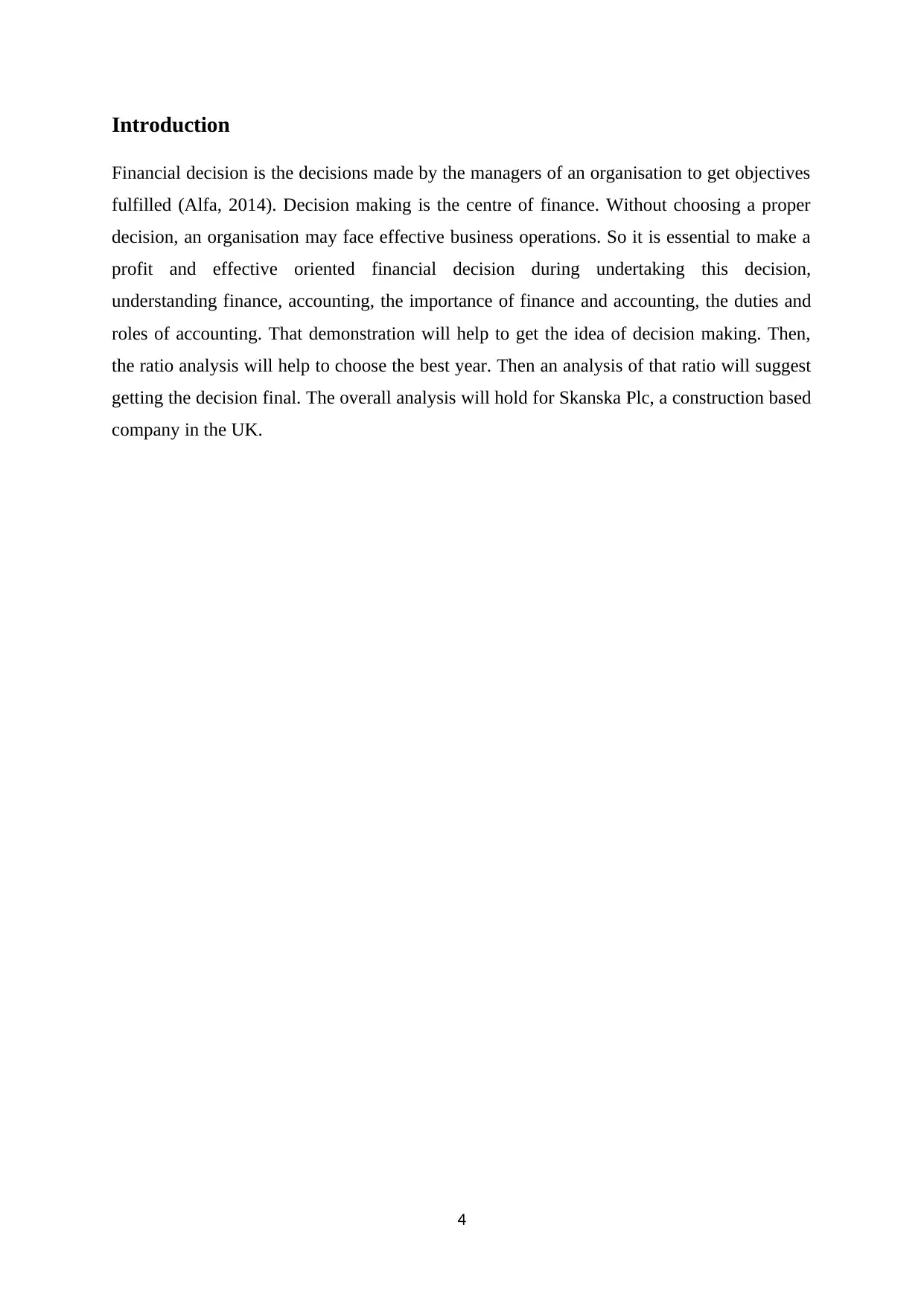
Introduction
Financial decision is the decisions made by the managers of an organisation to get objectives
fulfilled (Alfa, 2014). Decision making is the centre of finance. Without choosing a proper
decision, an organisation may face effective business operations. So it is essential to make a
profit and effective oriented financial decision during undertaking this decision,
understanding finance, accounting, the importance of finance and accounting, the duties and
roles of accounting. That demonstration will help to get the idea of decision making. Then,
the ratio analysis will help to choose the best year. Then an analysis of that ratio will suggest
getting the decision final. The overall analysis will hold for Skanska Plc, a construction based
company in the UK.
4
Financial decision is the decisions made by the managers of an organisation to get objectives
fulfilled (Alfa, 2014). Decision making is the centre of finance. Without choosing a proper
decision, an organisation may face effective business operations. So it is essential to make a
profit and effective oriented financial decision during undertaking this decision,
understanding finance, accounting, the importance of finance and accounting, the duties and
roles of accounting. That demonstration will help to get the idea of decision making. Then,
the ratio analysis will help to choose the best year. Then an analysis of that ratio will suggest
getting the decision final. The overall analysis will hold for Skanska Plc, a construction based
company in the UK.
4
Paraphrase This Document
Need a fresh take? Get an instant paraphrase of this document with our AI Paraphraser
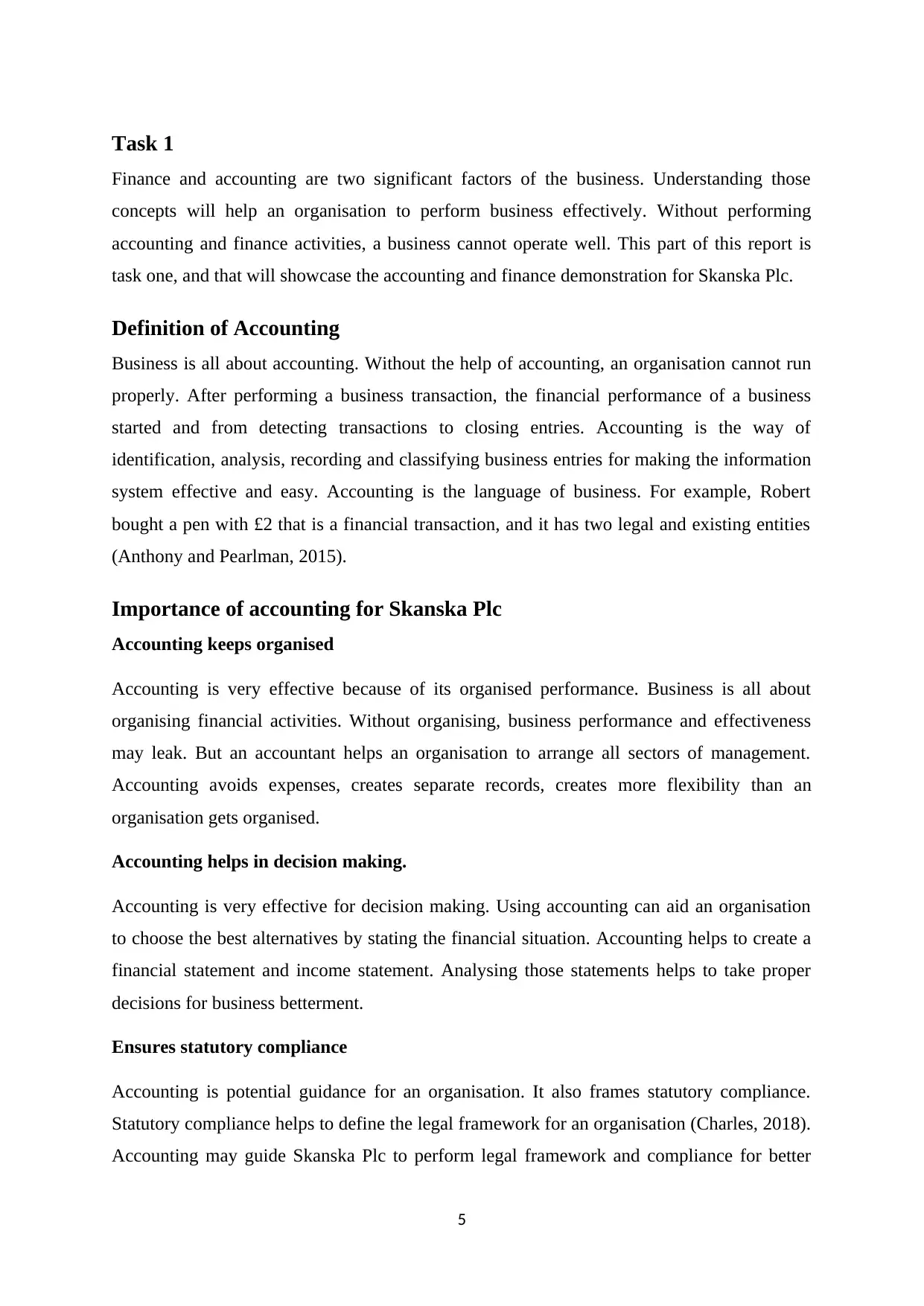
Task 1
Finance and accounting are two significant factors of the business. Understanding those
concepts will help an organisation to perform business effectively. Without performing
accounting and finance activities, a business cannot operate well. This part of this report is
task one, and that will showcase the accounting and finance demonstration for Skanska Plc.
Definition of Accounting
Business is all about accounting. Without the help of accounting, an organisation cannot run
properly. After performing a business transaction, the financial performance of a business
started and from detecting transactions to closing entries. Accounting is the way of
identification, analysis, recording and classifying business entries for making the information
system effective and easy. Accounting is the language of business. For example, Robert
bought a pen with £2 that is a financial transaction, and it has two legal and existing entities
(Anthony and Pearlman, 2015).
Importance of accounting for Skanska Plc
Accounting keeps organised
Accounting is very effective because of its organised performance. Business is all about
organising financial activities. Without organising, business performance and effectiveness
may leak. But an accountant helps an organisation to arrange all sectors of management.
Accounting avoids expenses, creates separate records, creates more flexibility than an
organisation gets organised.
Accounting helps in decision making.
Accounting is very effective for decision making. Using accounting can aid an organisation
to choose the best alternatives by stating the financial situation. Accounting helps to create a
financial statement and income statement. Analysing those statements helps to take proper
decisions for business betterment.
Ensures statutory compliance
Accounting is potential guidance for an organisation. It also frames statutory compliance.
Statutory compliance helps to define the legal framework for an organisation (Charles, 2018).
Accounting may guide Skanska Plc to perform legal framework and compliance for better
5
Finance and accounting are two significant factors of the business. Understanding those
concepts will help an organisation to perform business effectively. Without performing
accounting and finance activities, a business cannot operate well. This part of this report is
task one, and that will showcase the accounting and finance demonstration for Skanska Plc.
Definition of Accounting
Business is all about accounting. Without the help of accounting, an organisation cannot run
properly. After performing a business transaction, the financial performance of a business
started and from detecting transactions to closing entries. Accounting is the way of
identification, analysis, recording and classifying business entries for making the information
system effective and easy. Accounting is the language of business. For example, Robert
bought a pen with £2 that is a financial transaction, and it has two legal and existing entities
(Anthony and Pearlman, 2015).
Importance of accounting for Skanska Plc
Accounting keeps organised
Accounting is very effective because of its organised performance. Business is all about
organising financial activities. Without organising, business performance and effectiveness
may leak. But an accountant helps an organisation to arrange all sectors of management.
Accounting avoids expenses, creates separate records, creates more flexibility than an
organisation gets organised.
Accounting helps in decision making.
Accounting is very effective for decision making. Using accounting can aid an organisation
to choose the best alternatives by stating the financial situation. Accounting helps to create a
financial statement and income statement. Analysing those statements helps to take proper
decisions for business betterment.
Ensures statutory compliance
Accounting is potential guidance for an organisation. It also frames statutory compliance.
Statutory compliance helps to define the legal framework for an organisation (Charles, 2018).
Accounting may guide Skanska Plc to perform legal framework and compliance for better
5

business operation. Skanska Plc needs to ensure statutory compliance to get legal formwork
in financial performance management.
Evaluating performance gets easy.
Performance is the determinant of an organisation. Better performance defines effective
business results in contrast to dissatisfactory results. Accounting can help an organisation to
perform better by analysing, organising, and maintaining business operations. Skanska Plc
can perform better in expanding the business well.
Duties and roles of accounting within Skanska Plc
Accounting guides an organisation by playing various types of responsibilities. It has some
major roles and duties for operating the business efficiently. Without complying with those
roles and duties, Skanska Plc cannot expand the business and perform in Europe well.
Evaluating those duties and roles will help in the area of business operation.
Making financial statement
Accounting helps an organisation in various ways. Making a financial statement is one of the
vital duties of accounting. Creating income statements, financial statements, equity
statements, retained earnings statements for analysing business performance effectively.
Accounting helps to analyse financial statements by evaluating each item.
Controlling performance
Measuring performance during business operation is a common thing for an organisation, and
so is Skanska Plc. Accounting is the language of a business. Without understanding,
accounting performance cannot be measured. The performance of a business can be checked
by the asset, liability and equity, then choosing a decision can perform (Drury, 2017).
Creating budget
Budget creating is one of the essential roles of accounting. Without budget performing
business activities cannot be completed. Budget is the estimation for the future operation of
an organisation. For example, Skanska Plc plan to build one building in three months, and the
cost overall on construction will be £50000, and that is the estimation which is known as a
budget.
Assessing tax
6
in financial performance management.
Evaluating performance gets easy.
Performance is the determinant of an organisation. Better performance defines effective
business results in contrast to dissatisfactory results. Accounting can help an organisation to
perform better by analysing, organising, and maintaining business operations. Skanska Plc
can perform better in expanding the business well.
Duties and roles of accounting within Skanska Plc
Accounting guides an organisation by playing various types of responsibilities. It has some
major roles and duties for operating the business efficiently. Without complying with those
roles and duties, Skanska Plc cannot expand the business and perform in Europe well.
Evaluating those duties and roles will help in the area of business operation.
Making financial statement
Accounting helps an organisation in various ways. Making a financial statement is one of the
vital duties of accounting. Creating income statements, financial statements, equity
statements, retained earnings statements for analysing business performance effectively.
Accounting helps to analyse financial statements by evaluating each item.
Controlling performance
Measuring performance during business operation is a common thing for an organisation, and
so is Skanska Plc. Accounting is the language of a business. Without understanding,
accounting performance cannot be measured. The performance of a business can be checked
by the asset, liability and equity, then choosing a decision can perform (Drury, 2017).
Creating budget
Budget creating is one of the essential roles of accounting. Without budget performing
business activities cannot be completed. Budget is the estimation for the future operation of
an organisation. For example, Skanska Plc plan to build one building in three months, and the
cost overall on construction will be £50000, and that is the estimation which is known as a
budget.
Assessing tax
6
⊘ This is a preview!⊘
Do you want full access?
Subscribe today to unlock all pages.

Trusted by 1+ million students worldwide

Tax is a mandatory task for every organisation, and so is Skanska Plc. Without accounting,
tax assessment isn't possible. Tax can be assessed by accounting because accounting creates
income statements and net earnings; it also creates tax account. For those reasons, tax
assessment is required, which is impossible without accounting.
Reducing expense
Performing expenses is a common thing during business operations. But spending too many
expenses may tend an organisation is lack profitability. Using accounting will help to reduce
expenses by detecting unusual costs in operating costs, the hidden cost for Skanska Plc.
Aids to other departments
Without the help of the accounting department, an organisation cannot complete its overall
operation. A business usually depends on accounting, finance, and cost management
departments. Without keeping balance among those departments, the business cannot run
well. Skanska Plc should plan better for achieving business objectives and business
expansion (Gary, 2017).
Definition of Finance
Business is one of the dynamic platforms to run operations well. Finance is the backbone of a
business. Finance defines as a potential set of activities that are related to banking,
investment, leverage, financing, capital budgeting, and so many things. Business expansion
depends on a huge plan. The concept of finance will guide Skanska Plc to expand the
business by analysing all areas of performance.
Importance of Finance within Skanska Plc
Finance has various types of importance. Realising those important for Skanska Plc is a
potential task because the importance is an integral part that cannot be denied during business
operation.
Financing decision
Finance is very effective because of its financing decision. Without detecting the fund source,
an organisation cannot perform its activities began. So before starting a business, finance
works as an initial guide to detect the sources of financing that can be done only for finance.
7
tax assessment isn't possible. Tax can be assessed by accounting because accounting creates
income statements and net earnings; it also creates tax account. For those reasons, tax
assessment is required, which is impossible without accounting.
Reducing expense
Performing expenses is a common thing during business operations. But spending too many
expenses may tend an organisation is lack profitability. Using accounting will help to reduce
expenses by detecting unusual costs in operating costs, the hidden cost for Skanska Plc.
Aids to other departments
Without the help of the accounting department, an organisation cannot complete its overall
operation. A business usually depends on accounting, finance, and cost management
departments. Without keeping balance among those departments, the business cannot run
well. Skanska Plc should plan better for achieving business objectives and business
expansion (Gary, 2017).
Definition of Finance
Business is one of the dynamic platforms to run operations well. Finance is the backbone of a
business. Finance defines as a potential set of activities that are related to banking,
investment, leverage, financing, capital budgeting, and so many things. Business expansion
depends on a huge plan. The concept of finance will guide Skanska Plc to expand the
business by analysing all areas of performance.
Importance of Finance within Skanska Plc
Finance has various types of importance. Realising those important for Skanska Plc is a
potential task because the importance is an integral part that cannot be denied during business
operation.
Financing decision
Finance is very effective because of its financing decision. Without detecting the fund source,
an organisation cannot perform its activities began. So before starting a business, finance
works as an initial guide to detect the sources of financing that can be done only for finance.
7
Paraphrase This Document
Need a fresh take? Get an instant paraphrase of this document with our AI Paraphraser
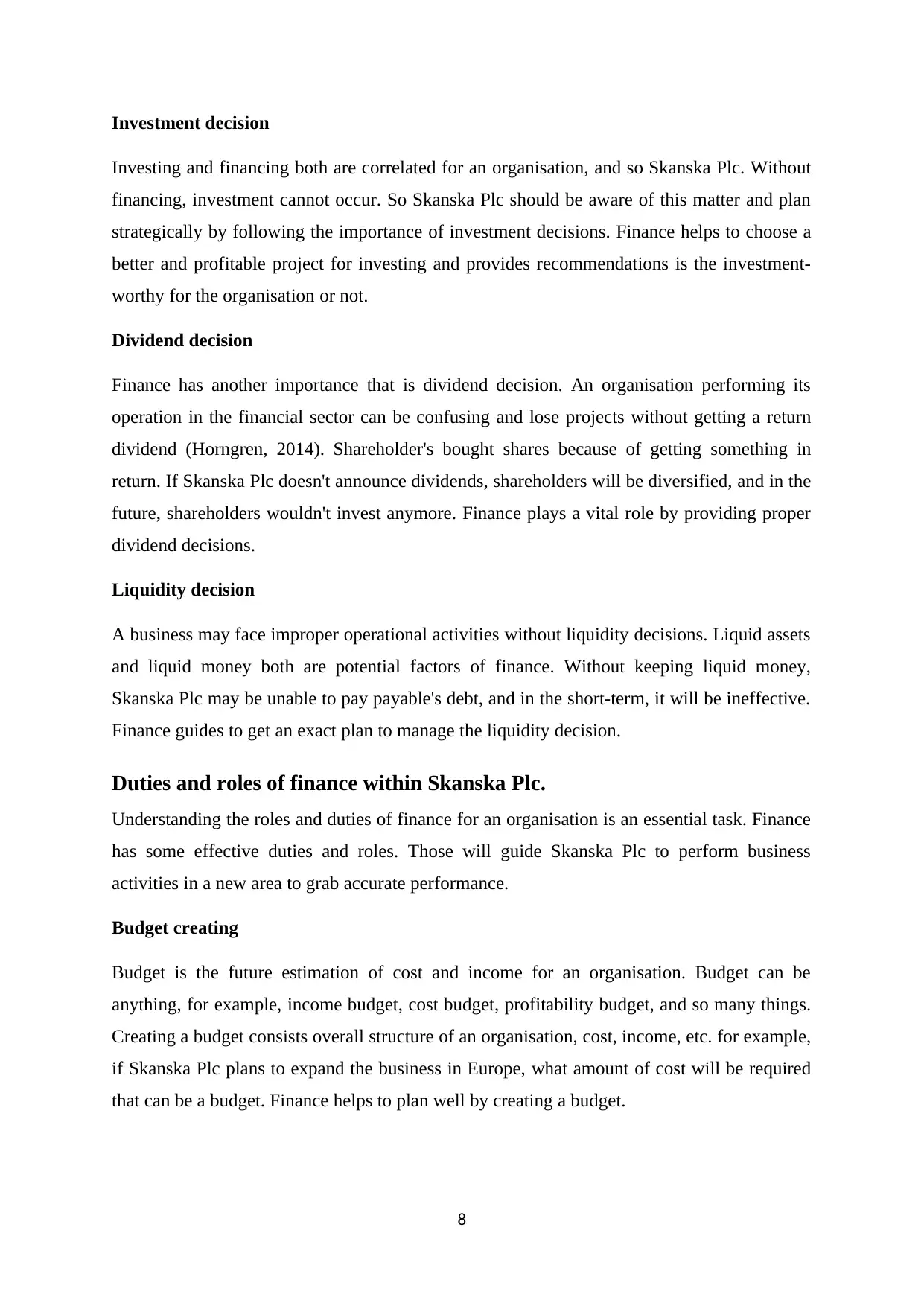
Investment decision
Investing and financing both are correlated for an organisation, and so Skanska Plc. Without
financing, investment cannot occur. So Skanska Plc should be aware of this matter and plan
strategically by following the importance of investment decisions. Finance helps to choose a
better and profitable project for investing and provides recommendations is the investment-
worthy for the organisation or not.
Dividend decision
Finance has another importance that is dividend decision. An organisation performing its
operation in the financial sector can be confusing and lose projects without getting a return
dividend (Horngren, 2014). Shareholder's bought shares because of getting something in
return. If Skanska Plc doesn't announce dividends, shareholders will be diversified, and in the
future, shareholders wouldn't invest anymore. Finance plays a vital role by providing proper
dividend decisions.
Liquidity decision
A business may face improper operational activities without liquidity decisions. Liquid assets
and liquid money both are potential factors of finance. Without keeping liquid money,
Skanska Plc may be unable to pay payable's debt, and in the short-term, it will be ineffective.
Finance guides to get an exact plan to manage the liquidity decision.
Duties and roles of finance within Skanska Plc.
Understanding the roles and duties of finance for an organisation is an essential task. Finance
has some effective duties and roles. Those will guide Skanska Plc to perform business
activities in a new area to grab accurate performance.
Budget creating
Budget is the future estimation of cost and income for an organisation. Budget can be
anything, for example, income budget, cost budget, profitability budget, and so many things.
Creating a budget consists overall structure of an organisation, cost, income, etc. for example,
if Skanska Plc plans to expand the business in Europe, what amount of cost will be required
that can be a budget. Finance helps to plan well by creating a budget.
8
Investing and financing both are correlated for an organisation, and so Skanska Plc. Without
financing, investment cannot occur. So Skanska Plc should be aware of this matter and plan
strategically by following the importance of investment decisions. Finance helps to choose a
better and profitable project for investing and provides recommendations is the investment-
worthy for the organisation or not.
Dividend decision
Finance has another importance that is dividend decision. An organisation performing its
operation in the financial sector can be confusing and lose projects without getting a return
dividend (Horngren, 2014). Shareholder's bought shares because of getting something in
return. If Skanska Plc doesn't announce dividends, shareholders will be diversified, and in the
future, shareholders wouldn't invest anymore. Finance plays a vital role by providing proper
dividend decisions.
Liquidity decision
A business may face improper operational activities without liquidity decisions. Liquid assets
and liquid money both are potential factors of finance. Without keeping liquid money,
Skanska Plc may be unable to pay payable's debt, and in the short-term, it will be ineffective.
Finance guides to get an exact plan to manage the liquidity decision.
Duties and roles of finance within Skanska Plc.
Understanding the roles and duties of finance for an organisation is an essential task. Finance
has some effective duties and roles. Those will guide Skanska Plc to perform business
activities in a new area to grab accurate performance.
Budget creating
Budget is the future estimation of cost and income for an organisation. Budget can be
anything, for example, income budget, cost budget, profitability budget, and so many things.
Creating a budget consists overall structure of an organisation, cost, income, etc. for example,
if Skanska Plc plans to expand the business in Europe, what amount of cost will be required
that can be a budget. Finance helps to plan well by creating a budget.
8
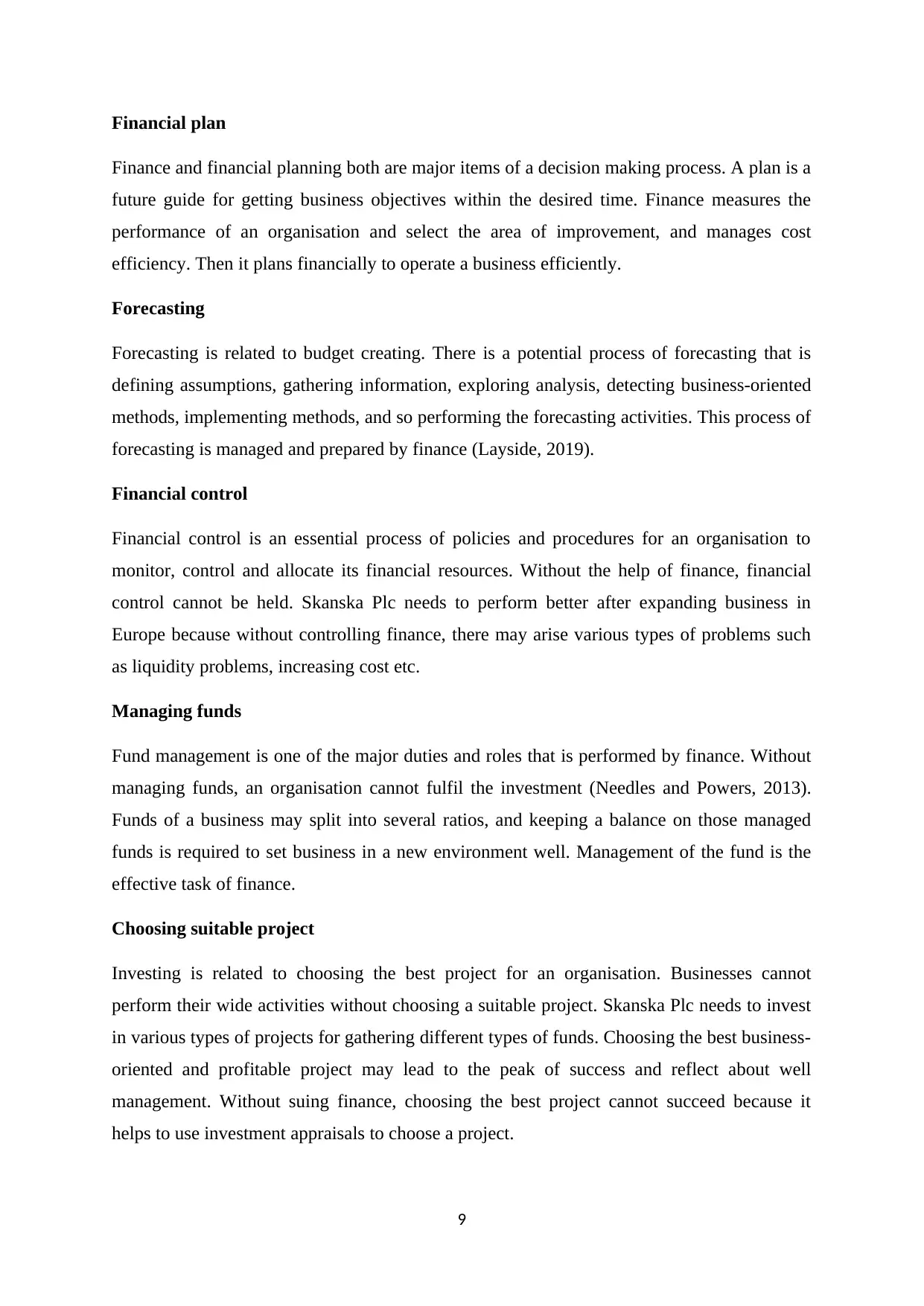
Financial plan
Finance and financial planning both are major items of a decision making process. A plan is a
future guide for getting business objectives within the desired time. Finance measures the
performance of an organisation and select the area of improvement, and manages cost
efficiency. Then it plans financially to operate a business efficiently.
Forecasting
Forecasting is related to budget creating. There is a potential process of forecasting that is
defining assumptions, gathering information, exploring analysis, detecting business-oriented
methods, implementing methods, and so performing the forecasting activities. This process of
forecasting is managed and prepared by finance (Layside, 2019).
Financial control
Financial control is an essential process of policies and procedures for an organisation to
monitor, control and allocate its financial resources. Without the help of finance, financial
control cannot be held. Skanska Plc needs to perform better after expanding business in
Europe because without controlling finance, there may arise various types of problems such
as liquidity problems, increasing cost etc.
Managing funds
Fund management is one of the major duties and roles that is performed by finance. Without
managing funds, an organisation cannot fulfil the investment (Needles and Powers, 2013).
Funds of a business may split into several ratios, and keeping a balance on those managed
funds is required to set business in a new environment well. Management of the fund is the
effective task of finance.
Choosing suitable project
Investing is related to choosing the best project for an organisation. Businesses cannot
perform their wide activities without choosing a suitable project. Skanska Plc needs to invest
in various types of projects for gathering different types of funds. Choosing the best business-
oriented and profitable project may lead to the peak of success and reflect about well
management. Without suing finance, choosing the best project cannot succeed because it
helps to use investment appraisals to choose a project.
9
Finance and financial planning both are major items of a decision making process. A plan is a
future guide for getting business objectives within the desired time. Finance measures the
performance of an organisation and select the area of improvement, and manages cost
efficiency. Then it plans financially to operate a business efficiently.
Forecasting
Forecasting is related to budget creating. There is a potential process of forecasting that is
defining assumptions, gathering information, exploring analysis, detecting business-oriented
methods, implementing methods, and so performing the forecasting activities. This process of
forecasting is managed and prepared by finance (Layside, 2019).
Financial control
Financial control is an essential process of policies and procedures for an organisation to
monitor, control and allocate its financial resources. Without the help of finance, financial
control cannot be held. Skanska Plc needs to perform better after expanding business in
Europe because without controlling finance, there may arise various types of problems such
as liquidity problems, increasing cost etc.
Managing funds
Fund management is one of the major duties and roles that is performed by finance. Without
managing funds, an organisation cannot fulfil the investment (Needles and Powers, 2013).
Funds of a business may split into several ratios, and keeping a balance on those managed
funds is required to set business in a new environment well. Management of the fund is the
effective task of finance.
Choosing suitable project
Investing is related to choosing the best project for an organisation. Businesses cannot
perform their wide activities without choosing a suitable project. Skanska Plc needs to invest
in various types of projects for gathering different types of funds. Choosing the best business-
oriented and profitable project may lead to the peak of success and reflect about well
management. Without suing finance, choosing the best project cannot succeed because it
helps to use investment appraisals to choose a project.
9
⊘ This is a preview!⊘
Do you want full access?
Subscribe today to unlock all pages.

Trusted by 1+ million students worldwide

Business is the combined platform of finance and accounting. The role of performing both
activities is a mandatory task to maintain operational activities well. The importance of
finance and accounting is an obligatory task for Skanska Plc because expanding business in a
new area will help to generate effective ideas about expanding and operating business well.
Task 2
Calculation of ratio analysis within Skanska Plc
i. Return on capital employed
Formula 2018 (£000) 2019 (£000)
Net operating profit / total
asset – total current
liabilities
= 750.00/4470.00 – 645.00 = 975 / 8070.00-2220.00
Result 16.78% 12.08%
ii. Net profit margin
Formula 2018 (£000) 2019 (£000)
Net income / total assets = 600.00/ 4800.00 =675.00 / 6000.00
Result 12.50% 11.25%
iii. Current ratio
Formula 2018 (£000) 2019 (£000)
Current asset / current
liabilities
= 1215.00 / 645.00 = 2070.00/2220.00
Result = 2.34:1 = 0.93:1
iv. Average receivable days
Formula 2018 (£000) 2019 (£000)
=Average accounts
receivable / total credit sales
* 365
= 450/ 4800*365 = 600/6000*35
10
activities is a mandatory task to maintain operational activities well. The importance of
finance and accounting is an obligatory task for Skanska Plc because expanding business in a
new area will help to generate effective ideas about expanding and operating business well.
Task 2
Calculation of ratio analysis within Skanska Plc
i. Return on capital employed
Formula 2018 (£000) 2019 (£000)
Net operating profit / total
asset – total current
liabilities
= 750.00/4470.00 – 645.00 = 975 / 8070.00-2220.00
Result 16.78% 12.08%
ii. Net profit margin
Formula 2018 (£000) 2019 (£000)
Net income / total assets = 600.00/ 4800.00 =675.00 / 6000.00
Result 12.50% 11.25%
iii. Current ratio
Formula 2018 (£000) 2019 (£000)
Current asset / current
liabilities
= 1215.00 / 645.00 = 2070.00/2220.00
Result = 2.34:1 = 0.93:1
iv. Average receivable days
Formula 2018 (£000) 2019 (£000)
=Average accounts
receivable / total credit sales
* 365
= 450/ 4800*365 = 600/6000*35
10
Paraphrase This Document
Need a fresh take? Get an instant paraphrase of this document with our AI Paraphraser
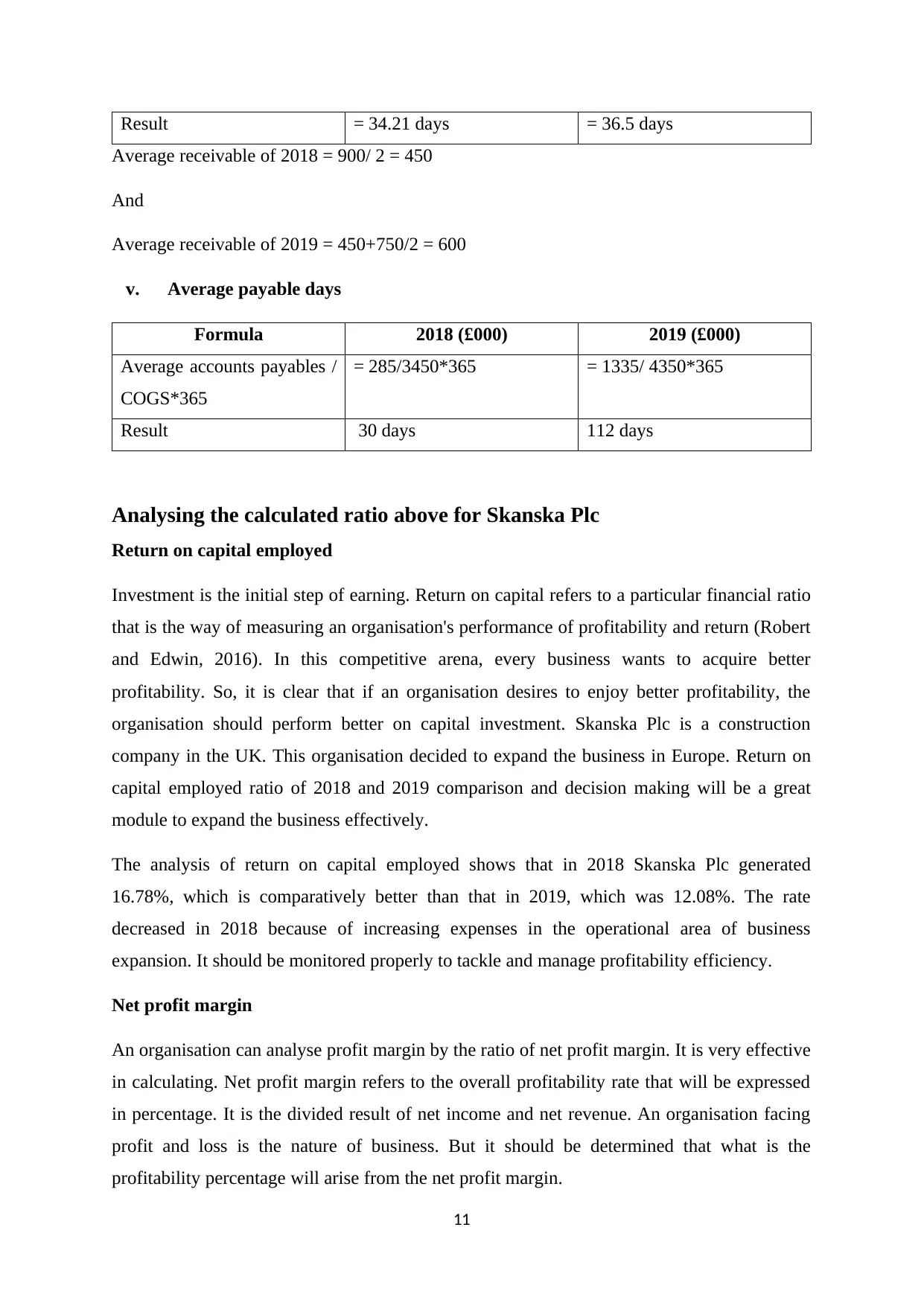
Result = 34.21 days = 36.5 days
Average receivable of 2018 = 900/ 2 = 450
And
Average receivable of 2019 = 450+750/2 = 600
v. Average payable days
Formula 2018 (£000) 2019 (£000)
Average accounts payables /
COGS*365
= 285/3450*365 = 1335/ 4350*365
Result 30 days 112 days
Analysing the calculated ratio above for Skanska Plc
Return on capital employed
Investment is the initial step of earning. Return on capital refers to a particular financial ratio
that is the way of measuring an organisation's performance of profitability and return (Robert
and Edwin, 2016). In this competitive arena, every business wants to acquire better
profitability. So, it is clear that if an organisation desires to enjoy better profitability, the
organisation should perform better on capital investment. Skanska Plc is a construction
company in the UK. This organisation decided to expand the business in Europe. Return on
capital employed ratio of 2018 and 2019 comparison and decision making will be a great
module to expand the business effectively.
The analysis of return on capital employed shows that in 2018 Skanska Plc generated
16.78%, which is comparatively better than that in 2019, which was 12.08%. The rate
decreased in 2018 because of increasing expenses in the operational area of business
expansion. It should be monitored properly to tackle and manage profitability efficiency.
Net profit margin
An organisation can analyse profit margin by the ratio of net profit margin. It is very effective
in calculating. Net profit margin refers to the overall profitability rate that will be expressed
in percentage. It is the divided result of net income and net revenue. An organisation facing
profit and loss is the nature of business. But it should be determined that what is the
profitability percentage will arise from the net profit margin.
11
Average receivable of 2018 = 900/ 2 = 450
And
Average receivable of 2019 = 450+750/2 = 600
v. Average payable days
Formula 2018 (£000) 2019 (£000)
Average accounts payables /
COGS*365
= 285/3450*365 = 1335/ 4350*365
Result 30 days 112 days
Analysing the calculated ratio above for Skanska Plc
Return on capital employed
Investment is the initial step of earning. Return on capital refers to a particular financial ratio
that is the way of measuring an organisation's performance of profitability and return (Robert
and Edwin, 2016). In this competitive arena, every business wants to acquire better
profitability. So, it is clear that if an organisation desires to enjoy better profitability, the
organisation should perform better on capital investment. Skanska Plc is a construction
company in the UK. This organisation decided to expand the business in Europe. Return on
capital employed ratio of 2018 and 2019 comparison and decision making will be a great
module to expand the business effectively.
The analysis of return on capital employed shows that in 2018 Skanska Plc generated
16.78%, which is comparatively better than that in 2019, which was 12.08%. The rate
decreased in 2018 because of increasing expenses in the operational area of business
expansion. It should be monitored properly to tackle and manage profitability efficiency.
Net profit margin
An organisation can analyse profit margin by the ratio of net profit margin. It is very effective
in calculating. Net profit margin refers to the overall profitability rate that will be expressed
in percentage. It is the divided result of net income and net revenue. An organisation facing
profit and loss is the nature of business. But it should be determined that what is the
profitability percentage will arise from the net profit margin.
11
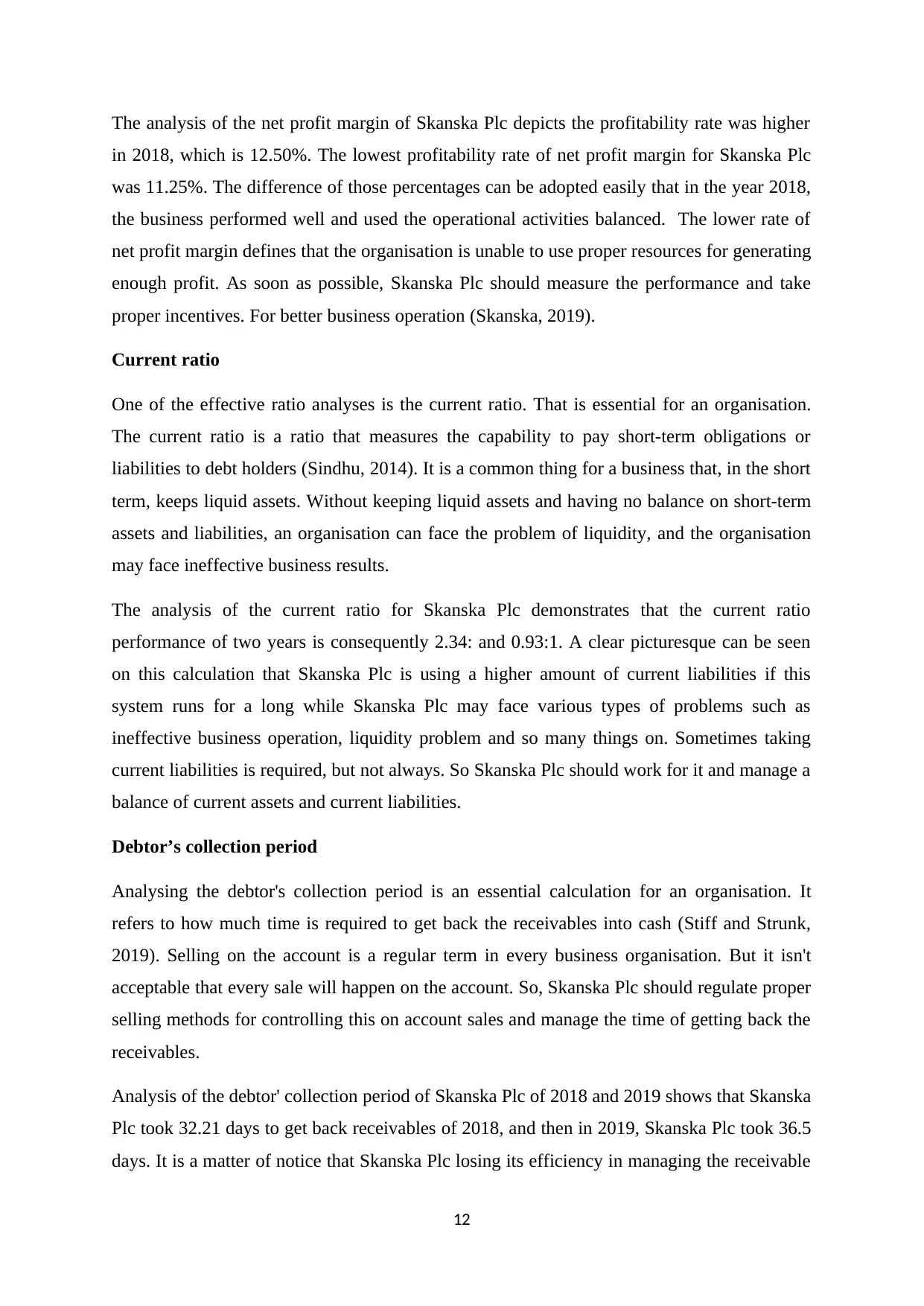
The analysis of the net profit margin of Skanska Plc depicts the profitability rate was higher
in 2018, which is 12.50%. The lowest profitability rate of net profit margin for Skanska Plc
was 11.25%. The difference of those percentages can be adopted easily that in the year 2018,
the business performed well and used the operational activities balanced. The lower rate of
net profit margin defines that the organisation is unable to use proper resources for generating
enough profit. As soon as possible, Skanska Plc should measure the performance and take
proper incentives. For better business operation (Skanska, 2019).
Current ratio
One of the effective ratio analyses is the current ratio. That is essential for an organisation.
The current ratio is a ratio that measures the capability to pay short-term obligations or
liabilities to debt holders (Sindhu, 2014). It is a common thing for a business that, in the short
term, keeps liquid assets. Without keeping liquid assets and having no balance on short-term
assets and liabilities, an organisation can face the problem of liquidity, and the organisation
may face ineffective business results.
The analysis of the current ratio for Skanska Plc demonstrates that the current ratio
performance of two years is consequently 2.34: and 0.93:1. A clear picturesque can be seen
on this calculation that Skanska Plc is using a higher amount of current liabilities if this
system runs for a long while Skanska Plc may face various types of problems such as
ineffective business operation, liquidity problem and so many things on. Sometimes taking
current liabilities is required, but not always. So Skanska Plc should work for it and manage a
balance of current assets and current liabilities.
Debtor’s collection period
Analysing the debtor's collection period is an essential calculation for an organisation. It
refers to how much time is required to get back the receivables into cash (Stiff and Strunk,
2019). Selling on the account is a regular term in every business organisation. But it isn't
acceptable that every sale will happen on the account. So, Skanska Plc should regulate proper
selling methods for controlling this on account sales and manage the time of getting back the
receivables.
Analysis of the debtor' collection period of Skanska Plc of 2018 and 2019 shows that Skanska
Plc took 32.21 days to get back receivables of 2018, and then in 2019, Skanska Plc took 36.5
days. It is a matter of notice that Skanska Plc losing its efficiency in managing the receivable
12
in 2018, which is 12.50%. The lowest profitability rate of net profit margin for Skanska Plc
was 11.25%. The difference of those percentages can be adopted easily that in the year 2018,
the business performed well and used the operational activities balanced. The lower rate of
net profit margin defines that the organisation is unable to use proper resources for generating
enough profit. As soon as possible, Skanska Plc should measure the performance and take
proper incentives. For better business operation (Skanska, 2019).
Current ratio
One of the effective ratio analyses is the current ratio. That is essential for an organisation.
The current ratio is a ratio that measures the capability to pay short-term obligations or
liabilities to debt holders (Sindhu, 2014). It is a common thing for a business that, in the short
term, keeps liquid assets. Without keeping liquid assets and having no balance on short-term
assets and liabilities, an organisation can face the problem of liquidity, and the organisation
may face ineffective business results.
The analysis of the current ratio for Skanska Plc demonstrates that the current ratio
performance of two years is consequently 2.34: and 0.93:1. A clear picturesque can be seen
on this calculation that Skanska Plc is using a higher amount of current liabilities if this
system runs for a long while Skanska Plc may face various types of problems such as
ineffective business operation, liquidity problem and so many things on. Sometimes taking
current liabilities is required, but not always. So Skanska Plc should work for it and manage a
balance of current assets and current liabilities.
Debtor’s collection period
Analysing the debtor's collection period is an essential calculation for an organisation. It
refers to how much time is required to get back the receivables into cash (Stiff and Strunk,
2019). Selling on the account is a regular term in every business organisation. But it isn't
acceptable that every sale will happen on the account. So, Skanska Plc should regulate proper
selling methods for controlling this on account sales and manage the time of getting back the
receivables.
Analysis of the debtor' collection period of Skanska Plc of 2018 and 2019 shows that Skanska
Plc took 32.21 days to get back receivables of 2018, and then in 2019, Skanska Plc took 36.5
days. It is a matter of notice that Skanska Plc losing its efficiency in managing the receivable
12
⊘ This is a preview!⊘
Do you want full access?
Subscribe today to unlock all pages.

Trusted by 1+ million students worldwide
1 out of 15
Related Documents
Your All-in-One AI-Powered Toolkit for Academic Success.
+13062052269
info@desklib.com
Available 24*7 on WhatsApp / Email
![[object Object]](/_next/static/media/star-bottom.7253800d.svg)
Unlock your academic potential
Copyright © 2020–2025 A2Z Services. All Rights Reserved. Developed and managed by ZUCOL.




